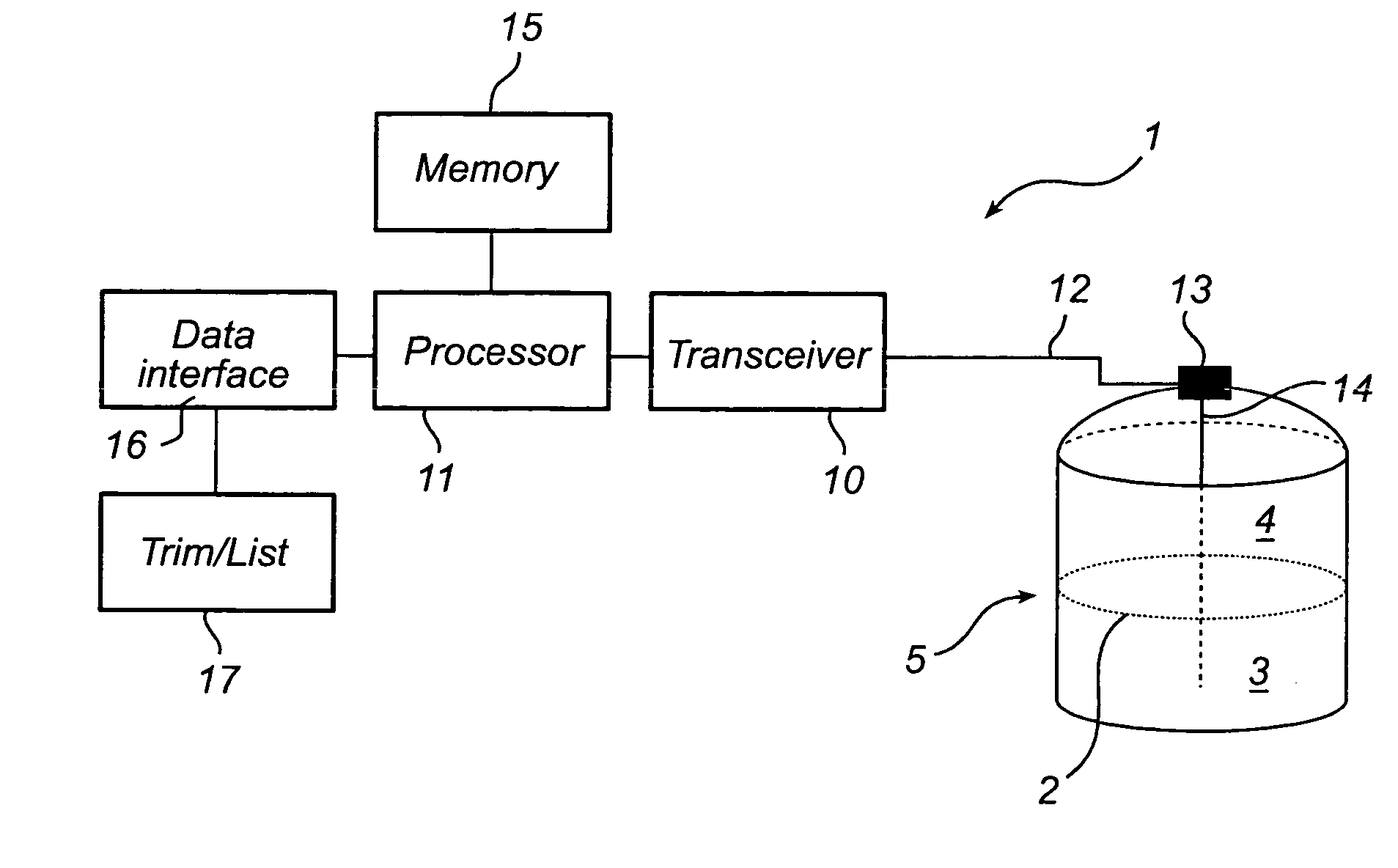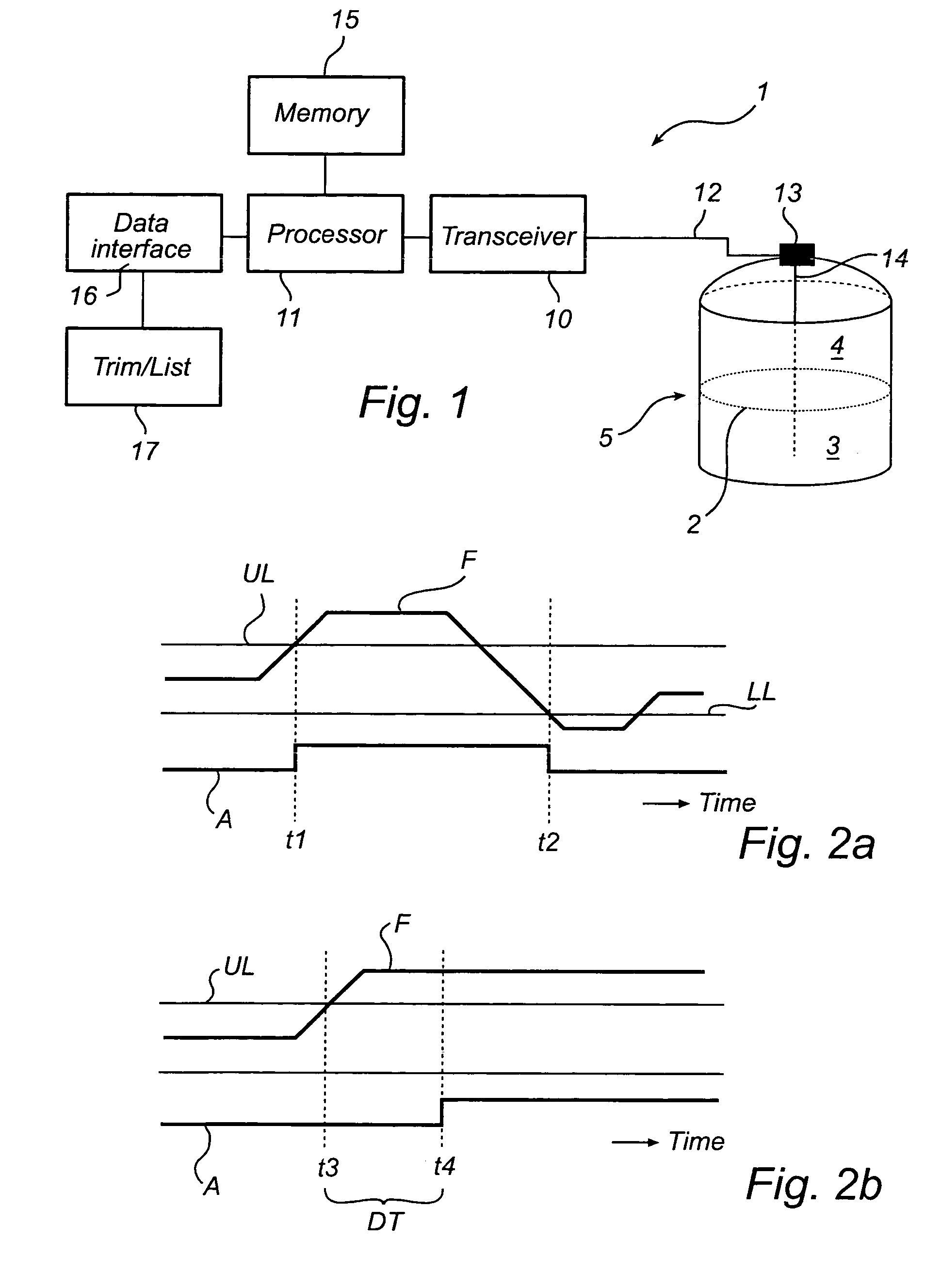[0013]The alarm radar level gauge system of the present invention provides a new type of alarm system, particularly for high level and / or overfill alarms, that enables adjustment of the threshold for the alarm levels when the system and / or sensor is already installed. For example, the system also enables automatic adjustment of the alarm limit and monitored level in real time as the trim and list of the ship changes during loading and off-loading to improve the capacity utilization and enable true volume fill correspondence independent of gauge / sensor location. It is estimated that by means of the invention the capacity of e.g. LNG (Liquefied Natural Gas) carriers could be increased by 0.2%.
[0014]Further, the non-contact system of the invention could easily be made very robust, accurate and reliable. Therefore, the ship operator would not need to walk out to all tanks and manually test the function of the float prior to entering a port, as is normally the case today. Further, the inventive system requires significantly less maintenance than e.g. mechanical systems which will improve the users profitability. Through higher reliability, the new system also enables the user to top off the tanks relying on the level system without having to manually go out to the tank and hand measure thereby improving operating performance, efficiency and productivity. Providing such a reliable alarm system also enables the operator to load at higher speed, whereby the turn around time in port could be decreased which increases efficiency, competitiveness and productivity for the ship operator.
[0015]Since the alarm limit can be adjusted on site, the new alarm limit can be set without replacing or modifying the installed hardware. Thus, the invention give advantages to the customer in terms of no waiting for re-building or modification of the measuring device, and a possibility to utilize the tank for its maximum allowed volume. It is further a great advantage that the alarm could be triggered at a monitored level that has first been corrected for any ship / tank inclination, especially if the gauging device is located at any other point than at the tank center. This enable true volume fill correspondence for the alarming.
[0021]The system could also comprise a data input means for inputting data for replacing or adjusting the threshold value in the storage means. The data input means could be a data input interface to be connected to an extern control unit or to a portable device such as a handheld computer. Alternatively, the data input means could comprise stationary input equipment, such as a keyboard, a touch screen or the like. The input means is preferably adapted to enable authorization and / or authentication control of input data. For example, the input means may request a password or similar authentication tokens in order to permit modification of the stored threshold data. The authorization and / or authentication control of the input data provides protection against erroneous or unauthorized manipulation of the system.
[0022]The input means could, as an alternative or in addition, be adapted to require confirmation by the operator on input data before adjusting the threshold value in the storage means. For example, the operator could be presented with a question such as “Do you really want to use this value as a new alarm limit?” or the like, whereby the adjustment is only executed upon a confirmative response. Further, the input means could be adapted to output confirmation data regarding the input data to the operator. This could e.g. be enabled by means of a message produced on a display, an audible message or the like. The input means could also be adapted to automatically confirm that the adjusted threshold value is reasonable before adjusting the threshold value in the storage means. Such a test for reasonability could e.g. be to confirm that the new value is within a certain range within which the threshold value must or is likely to reside, to confirm that the new value contains a predetermined number of digits, and the like. All the above measures could be used independently or in different combinations, in order to increase the security of the system, and avoid the risk of human errors and the like.
[0024]The processing circuitry is preferably adapted to produce an alarm signal when the determined filling level, preferably a monitored trim and list corrected level as discussed in the foregoing, exceeds a first threshold value. The first threshold value may be the only threshold value, or one of several different stored threshold values. An activated alarm signal could be deactivate as soon as the determined filling level is again lower than the first threshold value. However, it is also possible to provide a second threshold value and deactivate the produced alarm signal when the determined filling level is lower than said second threshold value, said second threshold value corresponding to a lower filling level than said first threshold value. Hereby, the alarm is activated at a higher level than it is deactivated, so-called hysteresis, which makes the system more stable. In addition or as an alternative, it is also possible to delay the activation of the alarm for a certain time period, i.e. only to produce the alarm signal when the determined filling level exceeds a first threshold value during a predetermined time period. Such a measure also makes the system more stable.
 Login to View More
Login to View More  Login to View More
Login to View More 

